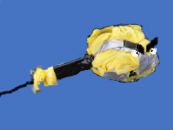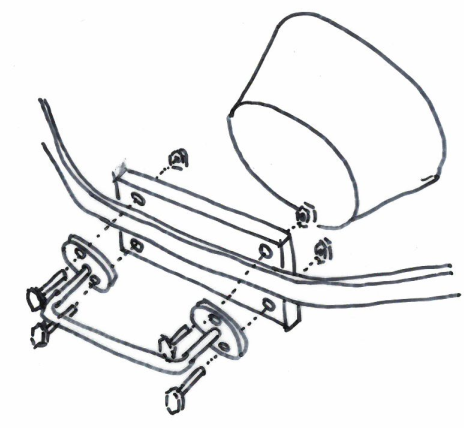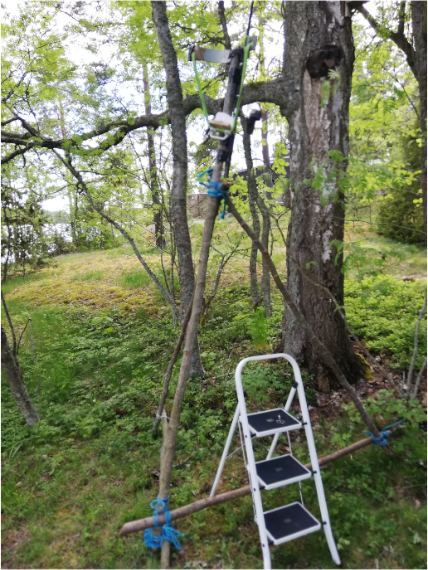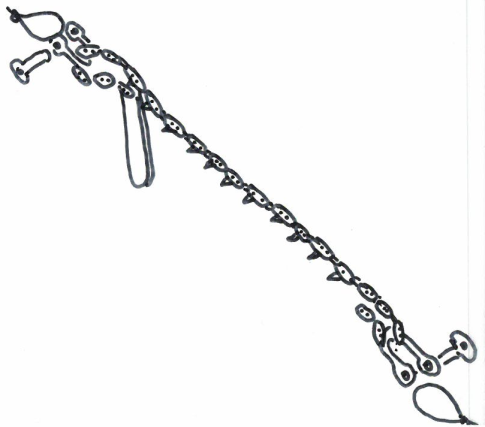The problem is: Old rotten birch, right next to the cottage. A few branches still bear leaves, but many of the branches are already without bark. Every winter there are storms with thick branches dropping. The branches may damage the roof. The
tree is leaning towards the cottage, may cause grave problem. It would be best to cut very rotten branches. The lifting platform is expensive and leaves marks on the lawn.

I have heard that there is such a thing as a rope saw. A about 15m long climbing rope is attached to the blade of the chainsaw on both sides. The other rope end is thrown over the branch. A little wieght is attached to the saw blade, it keeps
the cutting teeth downwards. With the rope the chainsaw blade is towed up onto the branch to be cut so that the saw teeth lie against the rotten branch. The rope saw is then pulled alternately from both ends of the rope. The chainsaw teeth
will gradually start to bite into the rotten branch. As sawing progresses, a practical problem arises: Gradually, the saw chain gets stuck. Therefore, the saw angle should be as gentle as possible and therefore the ends of the ropes should
be as far apart as possible. To do this, I use a pulley, i.e. a small rope pulley with the possibility of attaching it to some other tree. Thus, it is possible that the saw chain remains as straight as possible and at the same time both ends
of the rope can be held in the hand at the same time and rhythmically pulled from both ends, so that a constant tension is maintained in the rope. That way, the rope saw stays as straight as possible and doesn't get stuck. Sweatty when I cut
across a 15cm thick branch. The first experiment takes place with a very low branch that still can be reached with a ladder. It is important that you can still get to the saw chain by hand when the chain gets stuck in the cutting slit.

When the branch to be cut is out of reach of the ladder, there is a problem of getting the rope thrown over the branch.First I try with self-made crossbow and arrows, but arrows stick to branches and do not fall down to the earth. The first attempts
with stones seem dangerous. Namely, the stones sometimes fall on the roof of the cottage, sometimes they nearly break the glass of windows. Also the neighbors cottage is dangerously close. Therefore, a bag filled with sand is better. The sandbag
must not be too heavy to still be thrown, but must be heavy enough not to get caught in any branch. The sandbag is wrapped with HVAC tape, so it becomes smooth and without wrinkles that couldstick to the tree branches.

However, it is not enough for me to throw that sandbag over its branch. You have to get the whole rope over the branch. But the climbing rope that needs to be used for sawing is way too heavy. There are a lot of shrubs under the tree that the
rope could clings to during the throwing. Therefore, the flight path of the sandbag must be very steep upwards, and the momentum must be strong. The rope that is fixed to the sandbag should be as light as possible.
That is why I build a slingshot. The power source of the slingshot is a green exercise rope, about 5mm x 15mm, later also a purple color about 5mm x 20mm. The ends of the rubber cord are attached to both ends of the forks of the slingshot. I build
a fork from a metal arch and a small piece of pipe. I found both metal parts at a scrap metal store. When I left for the scrap yard dealer, I didn’t have a clear picture of what kind of parts I wanted, but it was just an idea sketched up and
I let my imagination decide what parts of reality were going to be. The seller of the scrap shop helped find the parts. I found rwo pieces of metal in some corners of the scrap shop. The one piece is a metal arch which has apparently been
the mounting part of the electric pole transformer, and the pipe section has been a part of the street lighting pole in its previous life.
I drill through the metal arc and the pipe and put a steel nail through that hole so that both stay firmly together. In addition, I put a wooden wedge. Thus, a slingshot fork has emerged that can be attached to a DIY firing tripod.

I build a small spoon for the sandbag. That spoon consists of a small plastic bowl glued to a wooden plank. Below, is an ordinary furniture handle with which I can tighten the rubber cord. Bolts go through the wooden plank, the plastic bowl and
the handle and hold all firmly together, the rubber cord running below the wooden plank. At first tryout I just tried to fix the plastic jar directly to the rubber rope, but the solution breaks easily and only longs for a few shots.

I built the first model of this slingshot in the winter and tried it in the forests of my home town, because I am not at all sure if the idea is useful at all. My home town is mainly a Pine Forest, and I could get the sandbag flying in a fine arc over
the crowns of the trees. It gives me hope that the whole idea could work. Later, Särkisalo has a lot of bushes that are in the way of the flightpath, and harder to shoot.
At the cottage, I was building the first tripod model. I cut about 4m long young trees with a diameter of about 5cm. In the beginning, I tied the trees together with ropes. Later, I find that this rope lashing solution is too loose. The tripod
moves when I tighten the rubber rope and aiming becomes difficult.
The fishing line is attached to the sandbag, the whole idea is similar to the fisherman who throws a fishing hook at sea with a snare. I just replace the fishing hook with a sandbag and I don’t throw it horizontally into the sea but vertically
into a tree. I first need to get the fishing line over branch about 5m high, then it can be used to tow a slightly thicker white rope over the branch and only finally the actual climbing rope can be towed over the branch with the help of a
white rope. I have plenty of old snares for fishing lying around. Several are broken. But one is still working. That snare is placed next to the slingshot, maybe about half a meter behind just so that the fishing line can be freely spool off
the snare, when shooting.

When the sandbag is inside the cup, the end of the fishing line must be attached to the sandbag with a small fishing hook. Then use your entire body weight to tighten the rubber cord pulling on the handle of the throwing cup. Then, when the rubber
cord is at maximum tension, aim upwards in the direction of the branch. At the same time, care must be taken to ensure that the fishing line is as loose as possible. Then, when aimed properly, the throwing cup is released and flies up. The
sandbag is shot up to the tree. It whips and cuts off the little branches while flying. It often flies much higher than the branch I would have aimed at. Fortunately, the sandbag is heavy enough, and rarely sticks to any branches. However,
sometimes ot clinges to some branches but it is possible to pull it down by gently jerking with the fishing line. Often, however, it goes bad. At times, the throwing cup bumps into the slingshot fork with a hard blow, and the cup bounces with
a thud back to my face. In that blow, the plastic cup cracked many times. Sometimes the cup breaks, and I have to fix and re-glue it to the handle. Once even the rubber cord breaks. A fairly small percentage of launch attempts succeed, perhaps
only every tenth. But that's enough for me. The sandbag goes over a branch about 5m high, although the throwing bag has flown much higher, perhaps 10m. When there is a strong wind, I have to give up because the fishing line will go in the
wind, and it will clinge to small branches. After the shot I have look where that sandbag has dropped. Fortunately, the sandbag is yellow so that it can be easily found in the forest.

As soon as the sandbag with the fishing line is found, a brightly colored weight must be attached to the fishing line, both ends. A small white string, about 30m long, is then attached to the line hanging from the top of the tree. That rope diameter
is about 0.3mm, and luckily it is a smooth-surfaced Teflon style rope that doesn’t easily stick to twigs and bark. It’s also good that it’s white, because then it’s easy to find. The line is then towed over that white rope over its 7m high
branch.

The white rope then can pulls the climbing ropes over the branch. In this way climbing rope finnally hangs over the rotten branch. This has taken 2 days. In practice, I left it there and returned to town because the most difficult part of this
operation has been accomplished. And next week again with refreshed spirit!

Next week chainsaw blade is attached to one end of the hanging climbing rope. It’s reasonably easy because I have a small shackle at the end of the chainsaw and all I have to do is loosen the shackle screw. To the other end of the chainsaw I fix
another climbing rope, also with a shackle. The attachment must be proper, because if it gets stuck in a tree branch, there is no second chance.

Once the chainsaw got stuck so hard during sawing that I to use the winch to release it. However I was really scared that the saw chain would get stuck forever in the branch.
When the chainsaw is resting on branch, I now had to pull another climbing rope through the pulley so that the sawing angle is as gentle as possible. That is why it is good if the climbing ropes are as long as possible. The pulley is then attached
to some other tree trunk. So finally I can grab both ends of the rope. Gradually tighten the ropes so that the chainsaw rests on the branch to be sawn, with a slight angle. I take the ends of the rope and pull them alternately, so that the
saw chain gradually is eating lightly through the branch. Not too much force, otherwise the chain will get stuck. The deeper the saw groove, the lighter the sawing should get. In the last moments it is easiest because the branch’s own weight
begins to open the saw groove all by its own weight. At some point that branch then crashes down, then of course you have to watch that the branch doesn’t hit you. And at the same time, of course, the chainsaw chain drops down. Operation completed!
Later, I order a lumberjack who is cuts the whole old birch. To do this, I throw both climbing ropes over the branch. With their help, the lumberjack pulls the steel rope of his own lever type winch (comealong) over the branch of its tree. Then,
with this comealong, he is able to pull the birch out of the cottage, even though it leans slightly in the direction of the cottage, so that it falls in the opposite direction of the cottage. The birch trunk is about 50cm in diameter, and
the tree is terribly heavy, so a simple foot winch alone would hardly have been enough to push the birch out of the direction of the cottage.
Here's a crazy wood grouse. I met on a mushroom trip, and I hit his territory. A great experience to see wild animals.